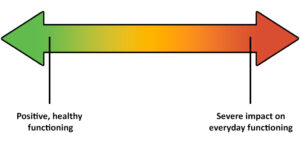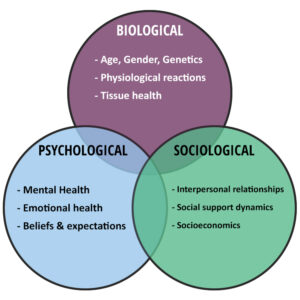A Health Psychologists’ perspective on Wellbeing at Work
This is part one of of a two-part series written by W2W Clinical Health Coaches Dr Anuska Randolph-Stephens and Kaylie Behan to read part 2, click here.
Wellbeing can be defined as ‘the state of feeling healthy and happy’ (Cambridge Dictionary, 2023). But what does this really mean? As a health psychologist, we take a holistic view of wellbeing recognizing that there are multiple components that influence our physical and mental health across our lifespan. But health exists on a continuum and can fluctuate.

We must also acknowledge how our health and wellbeing at work is a significant contributor to our overall health and wellness. Cultivating positive wellbeing both in and outside work is essential for overall good health. We spend a significant proportion of our time at work. Our jobs can be a source of stress or joy, satisfaction, or discontent. To have ‘good health’, we also need to have ‘good work’. Public health England (2019) published a report that notes ‘good work’ is better for your health than being out of work. This is defined as ‘having a safe and secure job with good working hours and conditions, supportive management and opportunities for training and development.’
From a health psychology point of view, we tend to view health through a biopsychosocial lens. The biopsychosocial approach (Engel, 1977) stipulates that the interplay of these areas of our lives influence our wellbeing. By taking these components into consideration, and nurturing each area, we can cultivate positive wellness. Let’s take a closer look.

Biological: Our physiological health is an important factor on our overall health which incorporates biological and genetic characteristics. By continuously nurturing your physical health by good nutrition, joyful physical activity, attaining good sleep, and understanding our own physiological needs, we can be one step closer to cultivating positive wellbeing.
Psychological: Our mental and emotional health is crucial to our overall sense of positive health and wellbeing. This involves our experience of stress, our self-esteem, our mindset, as well as the beliefs and expectations of ourselves, others, and the world we live in. We can support our mental health by engaging in activities that bring us joy, relaxation, or a sense of purpose. This can include mindfulness or deep breathing exercises for stress management, listening to an interesting podcast, or a day out with friends.
Social: This includes both environmental, cultural, and socio-economic factors that affect health. These environments in which we live can have a direct and indirect influence on our health choices and outcomes. Although not explicit, this would also include our occupation. Work can provide meaning and value to our lives, but also contribute to significant stress and ill health. A recent study found that when employees were asked ‘What are your priorities regarding your work today?’, working in a company that supports my wellbeing & health was the most important factor (JLL Work Preferences Barometer, 2022). Finding and cultivating an inclusive and healthy work environment is a significant way of supporting the wellness and wellbeing of the global workforce.
Occupation is however covered in a similar model used in Occupational Therapy, called the Personal-Environment model (Law et al., 1996). This is covered in part two of this series in the writing ‘An Occupational Therapist’s Perspective on Wellbeing at Work‘
At Working To Wellbeing, our team of Psychologists, Occupational Therapists and Physiotherapists provide a joined-up and holistic service where we have extended the biopsychosocial model to include work into the wellbeing equation (Denning and Hunter 2013).
Key message: Our wellbeing relies on the intricate matrix of all areas of our lives. Some might be thriving, and others more challenging at various times. But the effort to nurture our holistic selves will certainly lead to more positive wellbeing.
When it comes to supporting individuals with potentially complex multimorbidity health conditions, the biopsychosocial approach is an evidence-based method of understanding health and illness, as well as supports the creation and implementation interventions that are truly holistic and person-centred.
So, what do I do for my own health and wellbeing?
Well, I have two chronic health conditions. And over time, these have a fluctuating influence on my biopsychosocial health. To function at my best, I adhere to specific dietary and nutritional strategies to support my wellbeing and to optimise my daily functioning. Recently I have incorporated physical activity into my daily routine in the form of walking, both on my indoor treadmill throughout my working day, and in the great outdoors with my family at weekends.
For my psychological health, I engage in daily mindfulness strategies and breathing exercises to support stress management. I also have lots of plants around my house and workspace which promotes positive mental wellbeing. But I also know that walking improves my mental health both through the release of dopamine (the happy hormone), as well as the impact of being out in nature. Which leads nicely on to my social wellbeing. I enjoy my relationships with both lifelong friends and my work colleagues, as well as listening to music on my extensive vinyl record collection. I am also lucky enough to really enjoy my work. It is both a passion and career and gives my life a greater sense of meaning and purpose.
My question to you is: what are you going to do today to support your holistic health and wellbeing, using the framework of the biopsychosocial approach?
If you’d like to talk to us about wellbeing at work and how we support organisations through our work support services or training programmes, then please do get in touch
References and related content
– Engel G,L,. (1977) The need for a new medical model: a challenge for biomedicine. Science. Apr 8;196(4286):129-36. doi: 10.1126/science.847460. PMID: 847460.
– Public Health England (2019). Health matters: health and work. (Accessed on 21.06.23) https://www.gov.uk/government/publications/health-matters-health-and-work/health-matters-health-and-work
– JLL Work Preferences Barometer (2022). Referenced in Restoring employee wellbeing for the new world of work at https://www.weforum.org/agenda/2022/05/restoring-employee-wellbeing-for-a-new-healthier-world-of-work/ (Accessed on 22.06.23).
– Positive Psychology (2019). What is the Health Continuum Model? (Accessed on 22.06.23). https://positivepsychology.com/mental-health-continuum-model/.
– Psychology Today (2019). 11 Ways Plants Enhance Your Mental and Emotional Health. (Accessed on 22.06.23). https://www.psychologytoday.com/us/blog/cravings/201909/11-ways-plants-enhance-your-mental-and-emotional-health.
– Healthline. (Updated 2022). 10 Best Ways to Increase Dopamine Levels Naturally. (Accessed on 22.06.23). https://www.healthline.com/nutrition/how-to-increase-dopamine.
– Denning, J. and Hunter, N. (2013). ‘The ‘O’ in Biopsychosocial – focussing on work and health’. The Association of Chartered Physiotherapists in Occupational Health and Ergonomics Conference, 2013, Birmingham


